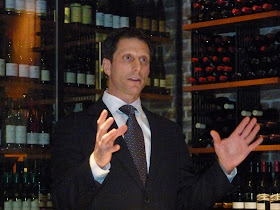Photo: Greata Ranch's lakeside winery
You might call Greata
Ranch Estate Winery a born-again winery even though it is 10 years old this
year.
“We want to give Greata
its own personality,” says Gordon Fitzpatrick, the president of CedarCreek
Estate Winery, which owns Greata Ranch.
That means making wines
there that are different from most of the wines in the CedarCreek portfolio.
Darryl Brooker, who also is CedarCreek’s winemaker, has made a reserve
Chardonnay and a reserve Pinot Noir for Greata Ranch.
In April, he is putting
down a cuvée (70% Pinot Noir, 30% Chardonnay) for a sparkling wine that Greata
Ranch plans to release for Christmas, 2015. And Greata Ranch will plant some
Pinot Meunier this year, giving him another of the classic Champagne
varieties.
This will be the first
sparkling wine from either CedarCreek or Greata Ranch, perhaps because
CedarCreek finally has a winemaker with sparkling wine experience.
Darryl Brooker
“I was making 10,000 cases
a year of traditional method sparkling in Ontario
There is, however, a bit
of déjà vu about the reserve wines. Six years ago, the winemaker then at Greata
Ranch, Corrie Krehbiehl, produced first-rate reserve Chardonnay and Pinot Noir.
Those wines were part of a project linked to a luxury 500-unit condominium
development. When the 2008 recession stopped that development in its tracks,
the reserve program also died. Greata Ranch went back to offering winery
visitors much the same wines that they could get at CedarCreek.
The Greata Ranch winery
and vineyard are south of Peachland, on a bench overlooking Okanagan Lake
The property is named after George W. Greata, a
British immigrant who arrived in the Okanagan in 1895 after a short stay at
Souris in Manitoba
The Long family vastly expanded fruit production,
building a large packing plant on piles extending from the shore into the lake,
with a wharf so that rail cars loaded with fruit could be barged to the closest
railhead. Because it was impractical to pump irrigation water steeply uphill
from the lake, the Longs secured rights for water from Brenda Lake
Orchardist Elwyn Cross had
the misfortune to buy the ranch just in time for the very hard 1965/66 winter
to kill many of the fruit trees. Over the next 28 years, the 110-acre property
went through several owners until its waterfront was given over to squatters’
shacks while the rest became an unofficial dump.
Senator Ross Fitzpatrick
bought the ranch in 1994. He recalled its glory days, having visited there with
his father, a packing house manager who bought some of Greata’s fruit. The
senator decided to plant about 32 acres of grapes, figuring that grapevines
would flourish where peaches formerly had thrived.
The senator had entered
the wine business in 1986 by buying struggling Uniacke Estate Winery in East Kelowna and re-launching it as CedarCreek. As that
winery moved into its second decade, it needed the grapes that Greata Ranch
could supply. (Subsequently, CedarCreek has developed two vineyards as well
near Osoyoos.)
The opening of a boutique winery at the ranch in
2003 was thrust upon the senator when the tourists began peeling off the nearby
highway, driving through the vineyard to knock at vineyard manager Merle
Lawrence’s door, looking for wine. The tasting room, with its bucolic lake
views, remains a favourite stop for wine tourists, particularity since the
highway was widened and a safe turn-in lane was created.
The 2006 foray into making
reserve wines for Greata Ranch was intended to be a sweetener in the proposed
Greata Ranch Vineyard Estates. Buyers of units in the estates would also have
preferred access to the wines. About 800 cases were made in the first year,
with the long term plan calling for a 5,000-case winery. The project stalled
when the real estate development stalled.
While the condominium
project has not yet been revived, there are plans now to put caves under the
tasting room for maturing sparkling wines. As well, Darryl has begun crafting
wines for Greata Ranch that are not just an echo of what CedarCreek is doing.
“We will transform the
little winery under the wine shop into a little sparkling cave and release the
wines under the Greata label,” Gordon says. “It will give people who drive by
Greata more reasons to stop.”




















